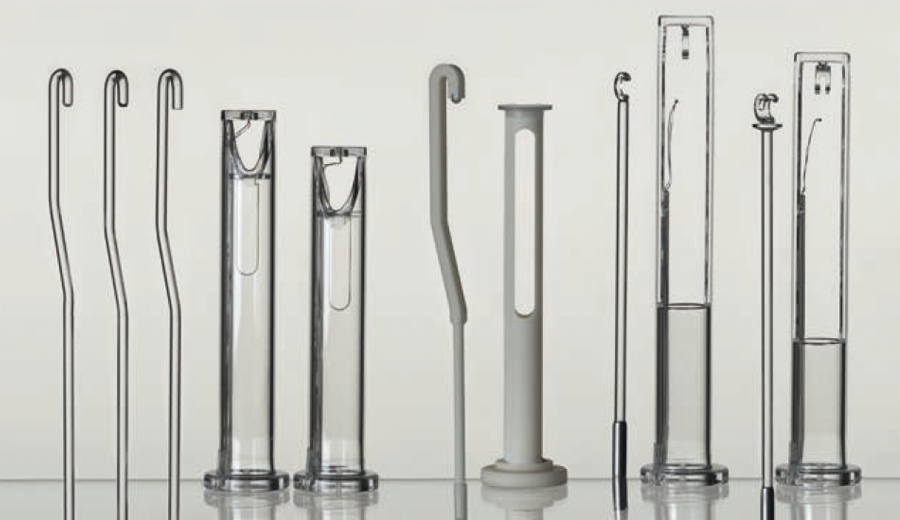Thermomechanical Analysis
for All Requirements

TMA/SDTA 2+
- STARe System
- Inovative Technology
- Versatile Modularity
- Swiss Quality
Features and benefits
- Wide temperature range
- SDTA
- One Click™
- Nanometer resolution
- Dynamic load TMA (DLTMA mode)
- Wide measurement range
- Modular design
- Hyphenated techniques
SDTA Signal
Unsurpassed Temperature Accuracy
The TMA/SDTA 2+ is the only instrument on the market that measures the sample temperature very close to the sample in all operating modes. This enables temperature adjustment to be carried out using reference substances (e.g. the melting points of pure metals) or through a change in length.

DLTMA mode
The DLTMA mode allows you to study the elastic behavior of samples.

Unique temperature calibration
The METTLER TOLEDO TMA models have two thermocouples: One mea- sures the furnace temperature and controls the program temperature. The other is located next to the sample and measures the sample temperature.
Optimized Sample Holders
for Quick and Easy Handling

The various deformation modes
Dilatometric mode (A): This is the mode most commonly used in ther- momechanical analysis. The expansion coefficient is determined as a function of temperature. A typical feature of this mode is that the probe exerts only a very small force on the sample.
Compression mode (A): In this mode, the sample is subjected to a large force.
Penetration mode (B): The purpose of a measurement in the penetra- tion mode is to determine the softening point of a sample. This is usu- ally performed using the ball-point probe.
Tension mode (C): The fiber or film accessory is used to perform mea- surements in tension. This allows you to determine changes in length due to shrinkage or expansion.
3-point bending mode (D): This mode is ideal for studying the elastici- ty of stiff samples such as fiber-reinforced polymers.
Swelling (E): Many substances swell when they come into contact with liquids. The resulting change in volume or length can be mea- sured using the swelling accessory.
Volume expansion (F): Liquids expand just like solids. A new acces- sory enables you to measure volume changes of liquids.

High-precision quartz glass measuring
probes and sample holders
Swiss quality is also clearly present in the measuring probes and sample holders. We supply the following types of quartz glass probes and sample holders:
- Sample holder for the measurement range 0 to 10 mm
- Sample holder for the measurement range 10 to 20 mm
TMA/SDTA 2+ Specifications
| Temperature data | LF/1100 | HT/1600 | IC/600 | LN/600 |
|---|---|---|---|---|
| Temperature range | RT to 1100 °C | RT to 1600 °C | –80 to 600 °C | –150 to 600 °C |
| Temperature accuracy (RT to max. temperature) |
±0.25 °C | ±0.5 °C | ±0.25 °C | ±0.25 °C |
| Temperature accuracy (–70/–100 °C to RT) |
n.a | ±0.35 °C | ±0.35 °C | |
| Temperature accuracy (–150 to –100 °C) |
n.a | n.a. | ±0.5 °C | |
| Temperature reproducibility | ±0.15 °C | ±0.35 °C | ±0.25 °C | ±0.25 °C |
| Heating (RT to max. temperature) | 8 min | 22 min | <6 min | <6 min |
| Heating (–70/–150 to 600 °C) | n.a | <7 min | <6 min | |
| Cooling (max. temperature to RT) | 20 min | <40 min | 13 min | <15 min |
| Cooling (RT to –70/–150 °C) | n.a | 22 min | 15 min | |
| Length data | ||||
|---|---|---|---|---|
| Maximum sample length | 20 mm | |||
| Measurement range | ±5 mm | |||
| Resolution | 0.5 nm | |||
| Noise (RMS) | 5 nm | |||
| Reproducibility | ±100 nm | ±300/±500 nm (1100/1600 °C) |
±100 nm | ±50 nm |
| Force data | ||||
|---|---|---|---|---|
| Force range | –0.1 to 1.0 N | |||
| DLTMA data | ||||
|---|---|---|---|---|
| Frequencies | 0.01 to 1 Hz | |||
| SDTA®-(Single differential Thermal Analysis) | ||||
|---|---|---|---|---|
| SDTA® resolution | 0.005 °C | |||
| SDTA® noise (RMS) | 0.01 °C | 0.01 °C | 0.02 °C | 0.02 °C |
| SDTA® sensor type | R type | K type | ||
| SDTA® signal time constant | 33 s | 33 s | 38 s | 38 s |
| Data sampling | ||||
|---|---|---|---|---|
| Sampling rate | max. 10 data points per second | |||

